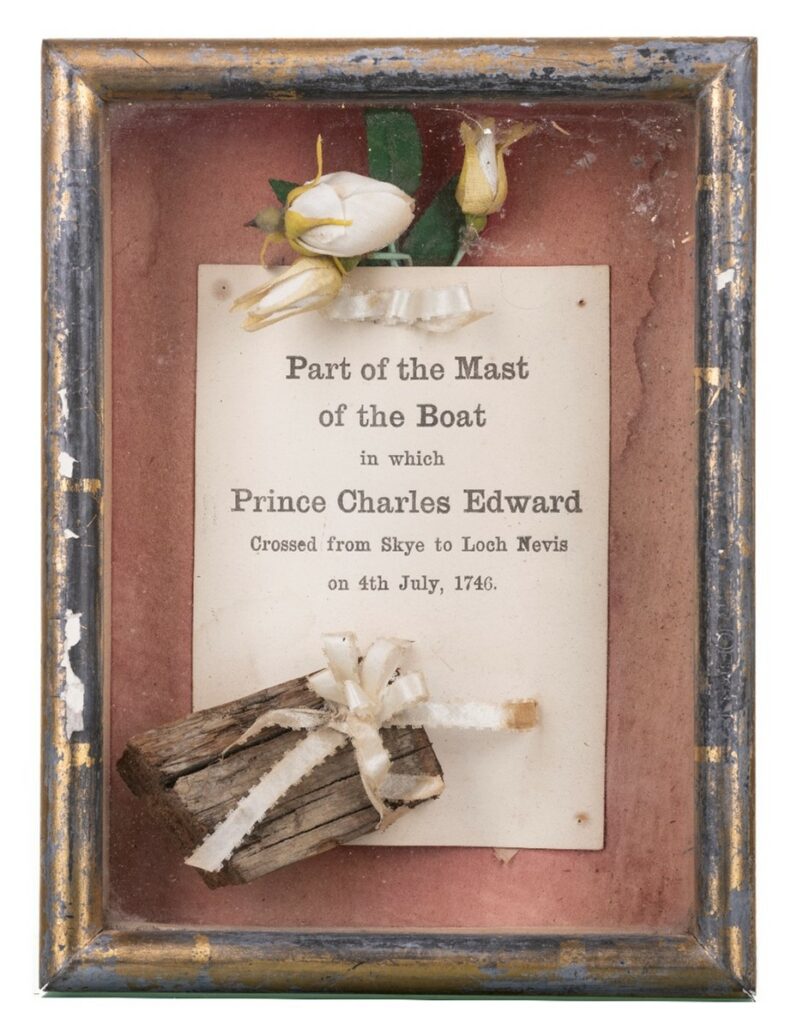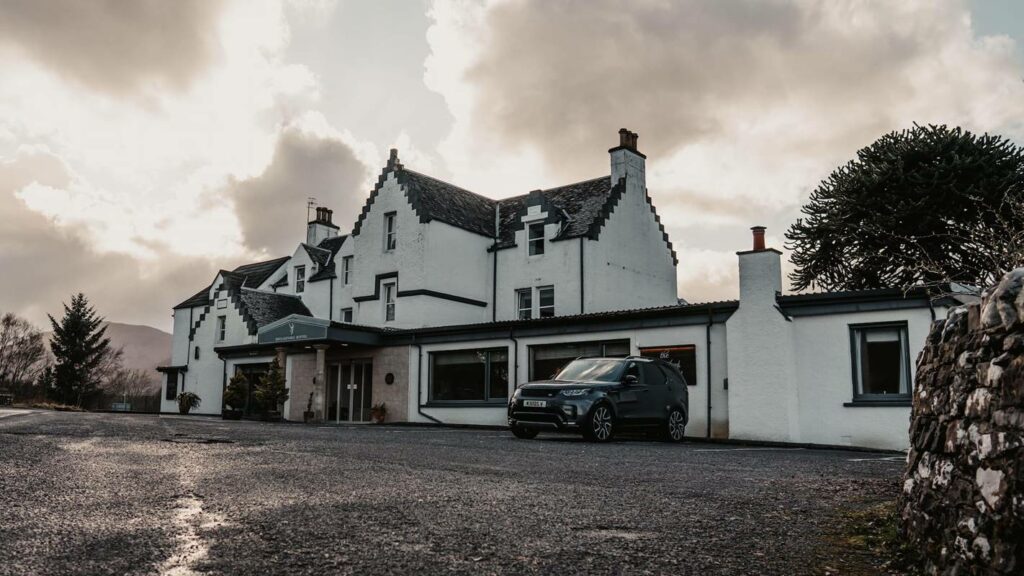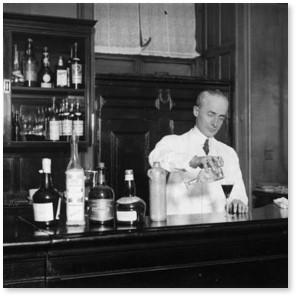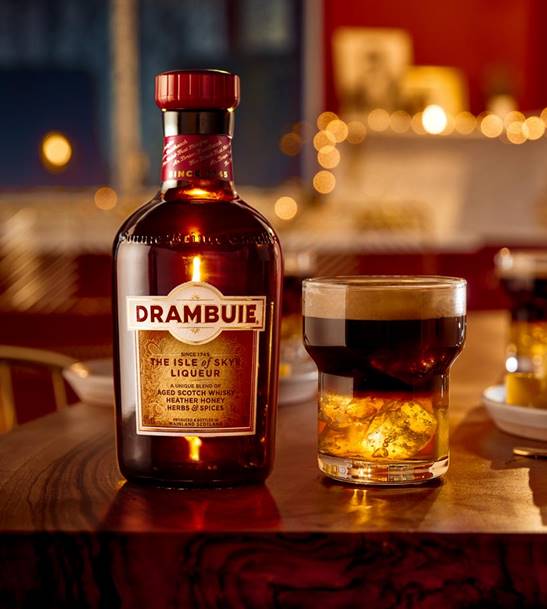Objects from the Drambuie Collection have been on loan to West Highland Museum since 2018 and can be viewed in our Jacobite Gallery.
Following on from our highly successful “An evening with Drambuie” event, Andy Fairgrieve from William Grant and Sons Ltd has written a blog for us focusing on the history of Drambuie liqueur.

As part of the loan of objects from the Drambuie Collection, there is currently on display at the West Highland Museum a small, framed piece containing to be what purports to be part of the mast of the boat in which Charles Edward Stuart was taken to safety from the Isle of Skye to the Scottish mainland on the 4th of July 1746.
The boat was crewed by members of Clan MacKinnon including their Chieftain Iain Dhu MacKinnon and Captain John MacKinnon of Elgol. The MacKinnon’s had crossed from Sleat to Loch Nevis undercover of night. However, on landing they discovered an encampment of redcoats and local government militia. The prince and his party were forced to hide in the heather by the foreshore for three days before setting off to sea once again. At this point they were spotted by the government troops who gave chase, yet the Mackinnon’s were the stronger rowers and soon gave them the slip.
When they landed again The prince hoped that old Clanranald would assist him but was refused. A follower of Clanranald, MacDonald of Morar however did offer shelter and even went to speak to Young Clanranald, who sadly was of the same opinion as his father and no assistance would be given.

With this news the prince, was distraught – ‘O God Almighty, look down on my circumstances and pity me; for I am in a most melancholy situation. Some of those who joined me at first, and appeared to be fast friends, now turn their backs on me in my greatest need. I hope, Mr MacKinnon, that you will not desert me too, and leave me in the lurch, but that you’ll do all for my preservation you can.’
‘Well then,’ replied John MacKinnon, ‘with the help of God, I will go through the wide world with your Royal Highness, if you desire me.’ As Good as his word Captain Mackinnon safe escorted the Prince to Borrodale where he discharged his duty into the safe hands of Angus Macdonald.
Perhaps it was at this point the gift from the prince was made to Captain John?
The gift in question being the recipe of the prince’s own personal elixir, handed over as a mark of gratitude.
This is the origin story behind Scotland’s best known and oldest whisky liqueur: Drambuie.
But what exactly did the prince gift to Captain John? The historical record tells us that in late April 1746, some two months before he met John MacKinnon, Prince Charles was in the Outer Hebrides under the protection of the Skye boatman, Donald MacLeod of Gualtergill. When MacLeod was later questioned about the state of the prince’s health at the time he replied:
‘He had a little bottle in his poutch out of which he used to take so many drops every morning and throughout the day, saying if anything should ail him he hoped he should cure himself, for that he was something of a doctor. And faith…he was indeed a bit of a doctor, for Ned Bourk happening ance to be unco ill of a cholick, the Prince said ‘Let him alane, I hope to cure him of that’ and accordingly he did so, for he gae him so many drops out o’ the little bottlie and Ned soon was as well as ever he had been’
So, this little bottle likely contained a highly concentrated eau-de-vie, concocted from a mixture of herbs spices and other flavourings, a few drops of which might be added to distilled spirit, such as brandy or whisky and sweetened with honey to make a cordial or punch. The popularity of such liqueurs was not just fashionable in the hight courts of 18th Century Europe but also a known practice in the highlands and islands of Scotland. Of course, following in the best oral tradition of the highlands as he handed over the bottle the prince likely intimated to Captain John the ingredients it contained as well as the proportions in which they should be used.
There may well be a degree of myth in this origin story it can not be denied that the MacKinnons of Skye were famed for the quality and potency of their cordials.
When James Boswell and Doctor Samuel Johnson visited Skye during their tour of the Western Isles in 1773, they were entertained by Lachlan MacKinnon of Corry. Boswell notes in his diary that he sat up with MacKinnon until five in the morning drinking what he described as a whisky ‘punch’.
While we can’t tell for certain which cordial Boswell received that night, the MacKinnons’ of Corry were known for one in particular which they called ‘The Yellow Drink’ – ‘dram buidhe’.

Then in the 1870s John Ross the proprietor of the Broadford Inn convinced a Mackinnon (said to be Alexander Kenneth Mackinnon of Corryie Lodge) to share the recipe of their famed liqueur so he might make it up for sale as a ‘house speciality’ in his bar. It is said that a tasting of the resulting drink was held one evening at which one of the drinkers proclaimed that it was ‘an dram buidheach’ – ‘the drink that satisfies.’
So just as the true origins of the drink are lost in the mists of time the precise origins of the name are equally unclear. ‘Buie’ is a phonetic spelling of ‘buidhe’, meaning ‘yellow’, but could also be an abbreviation of ‘buidheach’ (pronounced ‘booyuch’)
However, whichever version is preferred the name Drambuie stuck and it soon became popular with visitors to the Broadford Inn. So much so that in 1893 the son of John Ross, James, applied for a patent to trademark the name Drambuie. In doing so James might have been seeking to protect the name against a poor local imitation or indeed he could have had longer term plans to try and market the drink to a wider audience. Unfortunately, if this was his intention James never made it a reality as he passed away 1902. Eleanor tried to keep the family business going, bringing in a manager from Tongue but in 1908 The Broadford was sold to new owners and James’ widow Eleanor moved the family to Edinburgh, taking the Drambuie recipe with her.
That might have been the end of the Drambuie story had it not been for the intervention of another MacKinnon, Malcom (commonly known as Calum) who’s branch of the clan were to be found in Glenmore.
Malcom had moved to Edinburgh a few years before Eleanor and found employment at W. MacBeth’s and Son, a whisky merchant based in the New Town. By 1907 Malcom was a partner in the company and was looking on ways in which he might expand the business.
Like many of the Island community in the city Malcom attended St Orans Highland Church and it was here that he first came in to contact with Eleanor Ross and her family. The friendship between Malcom and Eleanors children grew and in 1908 an agreement was signed with Eleanor manufacturing and selling the drink out of Macbeths Union Street premises with MacBeths’ supplying the whisky and owning the trademark for the brand.

The first advert for Drambuie appeared in the Scots Pictorial Magazine in July 1908, interestingly it does not claim the recipe had come direct from Prince Charles but rather that it was handed over by a ‘follower’ of the Prince. Subsequent adverts however did state the drink had come directly from the Prince and reinforced the origins of the brand emphasising the link to the ’45 and proclaiming it as the Isle of Skye Liqueur.
Trade was initially slow with only 12 cases of the drink being sold in the first year, but Malcom still believed in the brand and so in 1912 MacBeths bought Eleanor out, giving them full ownership. However, Macbeths were themselves in trouble and so in 1914 Malcom made the bold move of buying out his partner to become the sole owner of the company and the Drambuie brand which he registered as the Drambuie Liqueur Company Limited separating it fully from MacBeths’
It was not just Drambuie that Malcom was introduced to by Eleanors family, one of her daughters, Meg had a close friend from Wick but now working as a schoolteacher in Edinburgh, Gina Davidson.
Romance blossomed between Gina and Malcom and the couple married in 1915. Straight away Gina became involved in the business, taking on responsibility for the purchase and mixing of the herbs and spices used in the drinks production. It is said she would often buy ingredients that were not actually part of the recipe to throw any potential imitators off the scent.
The outbreak of war in 1914 proved to have mixed fortunes for the whisky trade but the restriction of imports made Drambuie one of the only liqueurs avaible in the UK and by exploiting his connections and existing customers for Macbeths blended whisky brands (John o Groats and Fulstrenght) was able to grow the business. In 1917 orders started to come in to supply Drambuie to the House of Lords and the following year the cellars of Buckingham place. It also became a firm favourite in officers messes after the war, giving the brand international exposure and helping build its export trade value.
Of course, as prohibition gripped the North American market through the 1920s and 30s export trade was hit but one unexpected benefit came with the exodus of professional bar tenders such as Harry Craddock who left America to work in UK bars where they discovered Drambuie which they continued to champion in America once Prohibition ended in 1933.

In fact, one of the most famous Drambuie serves ‘The Rusty Nail’ is said to have gained its name from the prohibition practice of smugglers often dropping crates of their contraband overboard offshore of their intended market with a small floating bladder to act as marker so that they might be retrieved at a later date. Of course, the salt water corroded the nails that held the crate together, hence The Rusty Nail !
With Malcom passing in 1945, Gina’s brother Willam Davidson took over the running of the company. By the 1960s Gina had become chair of the company with her brother Willam as vice Chair and her eldest son Norman looking after day to day running of the business.
Gina travelled extensively promoting the brand, often accompanied not by one but two personal pipers, in America where the brand enjoyed great popularity following the end of Prohibition, she became to be known as ‘The Canny Scots Granny with the $2 million secret’. Gina used to continue to prepare the concentrate used in Drambuie (with only 4 small vials containing enough to make 1200 gallons of Drambuie) until her death in 1977.
As the brand became more popular it quickly outgrew its first home in the New Town’s Union Street and in 1940 production moved to Dubin Street with a further move in 1955 to Easter Road. In 1959 it moved once again to Kirkliston where it remined until production and bottling was contracted out in 2001, initially to the Glenmorangie plant in Broxburn then in 2010 to Morrison Bowmore Distillers Ltd.

In 2014 the brand was sold for a reported £100 million to another family-owned firm, William Grant and Sons Ltd. The new owners took a long hard look at the brand and quickly moved from the redesigned bottle and brand imagery introduced in 2005, returning to a design more in keeping with its established heritage of a squat brown glass bottle with its gold label famous red top and Bonnie Prince Charlie embossed on the shoulder of the bottle.
Also, a new signature serve has been created, the Drambuie iced coffee, a simple mix of equal measures of strong cold press coffee and Drambuie over ice to make a luxurious indulgent after dinner treat.
For more information on the Drambuie story and the ways it may be enjoyed please visit
Drambuie. A Blend Of Scotch Whisky, Heather Honey, Herbs & Spices
